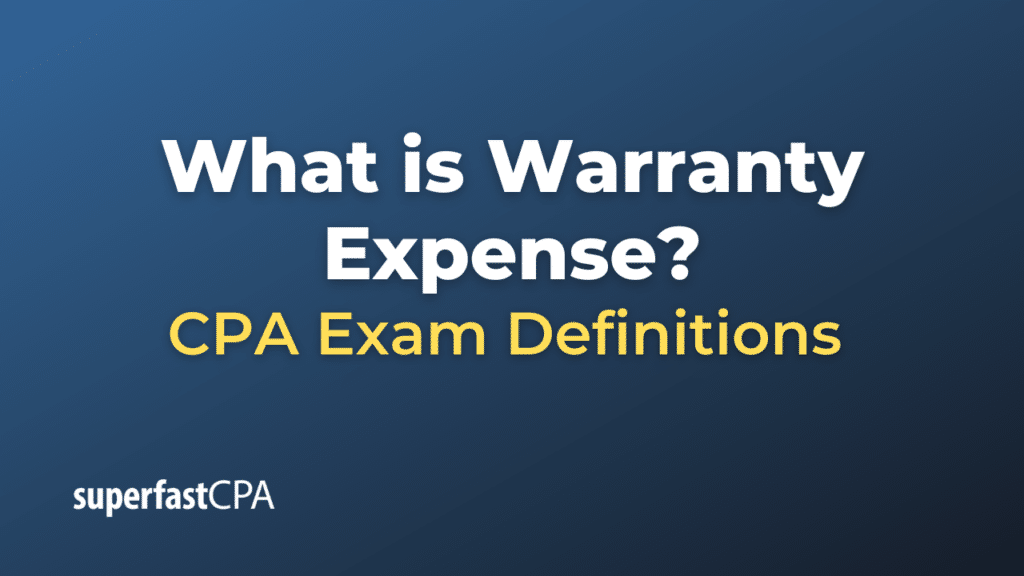Warranty Expense
Warranty expense is an accounting term that refers to the estimated cost a company expects to incur for repairing, replacing, or refunding products during a warranty period. This expense is recognized in the same period in which the revenue from the product sale is recognized, following the accrual accounting method and the matching principle. The matching principle requires that expenses be matched with the revenue they help to generate; thus, warranty expense is recorded in the same period as the sales revenue to give a more accurate picture of a company’s profitability.
In essence, warranty expense is a provision or reserve that the company sets aside to meet its future obligations related to product warranties. This expense is a liability on the balance sheet and an operating expense on the income statement.
How is Warranty Expense Estimated?
Companies typically use historical data, statistical analysis, or industry benchmarks to estimate the warranty expense. They consider factors like:
- The percentage of products expected to be returned or repaired.
- The average cost of repair or replacement.
- The duration of the warranty period.
Accounting for Warranty Expense
When a product is sold with a warranty, the company makes a journal entry to recognize both the revenue from the sale and the associated warranty expense. A typical set of journal entries could look like:
- Recognize Revenue and Accounts Receivable (if applicable)
- Debit: Accounts Receivable
- Credit: Sales Revenue
- Recognize Warranty Expense and Liability
- Debit: Warranty Expense
- Credit: Warranty Liability
Adjusting Warranty Expense
Companies will adjust the warranty liability account as actual warranty expenses are incurred. For example, when a product is repaired under warranty:
- Debit: Warranty Liability
- Credit: Inventory or Accounts Payable (for parts)
- Credit: Cash or Accounts Payable (for labor)
Periodically, companies may also revise their estimates for warranty expense based on new information, like changes in product return rates or repair costs, and adjust the warranty liability and expense accounts accordingly.
Understanding and accurately estimating warranty expense is crucial for both financial reporting and operational planning. It allows a company to set aside sufficient resources to meet future obligations, and it provides investors and analysts with a more accurate picture of the company’s financial health.
Example of Warranty Expense
Let’s consider a fictional company called “AutoElite” that manufactures and sells luxury cars. AutoElite offers a three-year or 36,000-mile warranty on its vehicles, covering engine and transmission issues.
Background:
Based on historical data and industry benchmarks, AutoElite estimates that about 2% of the cars sold will require warranty-covered repairs in the first year, at an average repair cost of $1,000 per car.
Scenario:
- Initial Sales: AutoElite sells 200 cars in the month of January at an average selling price of $50,000 per car, totaling $10,000,000 in revenue.
- Warranty Expense Estimate:
- 200 cars x 2% (estimated returns) = 4 cars
- 4 cars x $1,000 (estimated repair cost) = $4,000
Accounting Entries:
At the Time of Sales in January:
- Recognize Sales Revenue and Accounts Receivable:
- Debit: Accounts Receivable $10,000,000 (200 cars x $50,000)
- Credit: Sales Revenue $10,000,000
- Recognize Warranty Expense and Liability:
- Debit: Warranty Expense $4,000
- Credit: Warranty Liability $4,000
During February, When Actual Warranty Costs Are Incurred:
Suppose that 3 cars actually come back for warranty repairs in February, and it costs AutoElite $950 per repair, totaling $2,850.
- Adjust Warranty Liability for Actual Costs:
- Debit: Warranty Liability $2,850 (3 cars x $950)
- Credit: Inventory or Accounts Payable $2,850
Mid-Year Adjustments:
By June, AutoElite reviews its warranty performance and finds that the average repair cost has been $950 rather than the $1,000 initially estimated.
- New Warranty Liability Estimate:
- Remaining cars under warranty: 200 – 3 = 197 cars
- 197 cars x 2% (estimated returns) = 3.94 (approximately 4 cars)
- 4 cars x $950 (new estimated cost per repair) = $3,800
- Adjust Warranty Liability:
- Debit: Warranty Expense $200 ($4,000 old estimate – $3,800 new estimate)
- Credit: Warranty Liability $200
This example illustrates the same principles as the previous one but in a different industry context. It shows how warranty expense is estimated, recognized, and then adjusted as actual costs become clear and as new estimates are made. This process ensures that AutoElite’s financial statements give an accurate picture of both its revenue and expected future obligations.













